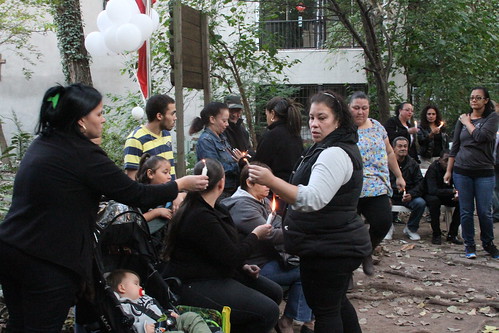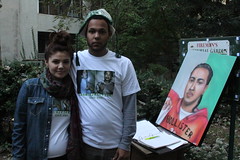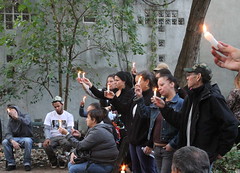 Annie Fairman Aida Salgado (front, center) lit candles with friends and family in rememberance of her late son.
Annie Fairman Aida Salgado (front, center) lit candles with friends and family in rememberance of her late son.At a memorial service Sunday, Aida Salgado recalled the early morning, on Oct. 16, that her son was shot in the courtyard of the Campos Plaza housing development, and the year that has followed. “My world came crashing down, and I was engulfed in a wrenching pain that only can be felt by another parent who has lost a child,” she told friends and family members gathered at Firemen’s Memorial Garden on Eighth Street.
Stephanie Federico, who wore a t-shirt depicting Donovan “Keith” Salgado, said she had expected the 17-year-old’s tragic death to put a damper on youth violence in the neighborhood. “People felt as though maybe it was gonna be over after he passed,” she told the gathering of about a couple dozen people. “But a lot of things didn’t end. It actually made things a lot worse.”
Another attendee left little doubt about the matter: Maizie Arroyo, a longtime resident of the East Village who recently moved to the Bronx, said that on the subway ride to the memorial, a group of young men tried to “jump” one of her teenage companions because he was wearing a laminated photo of Mr. Salgado around his neck.
“We had to let them know, ‘Look, this is not the time or the place,'” she said of the would-be attackers, whom she believed to be residents of the Alfred E. Smith Houses. “I was trying to give them some advice like, ‘You’re young people. You all need to stop this: what are you going to die for? Look what he died for. We don’t want to see anymore of our young people dying.”
Hockeem Smith, 24, was collared for last year’s murder, but a couple of shootings last month underlined Ms. Salgado’s fears that gun violence is out of control in the East Village. One of the recent incidents was touched off by the mention of Keith Salgado during an open-mic battle, according to the father of the event’s organizer.
After a Community Council meeting last night, Deputy Inspector John Cappelmann, the commanding officer of the Ninth Precinct, told The Local that the incident wasn’t directly related to the murder of Keith Salgado. But, he added, “It’s involving the same groups of people.”
Those groups are the Money Boys of Campos Plaza and Stacks of Baruch Houses, which he described as “a geographical gang based on a block or a development” rather than a traditional gang such as the Bloods and Crips.
“But there’s definitely low-level drug dealing,” he added. “They’re doing robberies left and right.”
Mr. Smith was said to be an associate of Stacks.
Myrna, a longtime friend of Aida Salgado and fellow parent who asked that her last name not be used, said that the problem of youth violence was compounded by an unwillingness to speak out. “Everyone can be in an area where something occurs, and they’ll just turn away – oh I didn’t see it – in this situation, nobody’s story matches – there’s like a hundred stories,” she said. “And everybody that was there, physically there, none of their stories match.”
Memorial attendees confirmed that carrying guns and other weapons is widespread, often driven by fear. “It really boils down to people feeling alone in the streets,” said Jeremia Guzman, 20, a former Lower East Side resident who now lives in New Jersey. “You always have your friends but then at the end of the day can you really count on your friends when there’s a gun involved?”
Seated on a park bench, Andre Tirado, 16, a neighbor and friend, said he still felt Keith’s presence.
“Don’t you feel like sometimes you’re gonna walk through the neighborhood and you’re gonna see him?” Mr. Tirado asked Mr. Guzman, who also wore a t-shirt with Salgado’s image. “It still don’t feel the same.”
“I miss him every single day,” Mr. Guzman said. “There’s not a day that goes by that I don’t think about him.”
The group lit white candles and released white balloons into the sky. After a final prayer, the candles were extinguished. The group stayed in the garden, eating and talking as the sun set.






